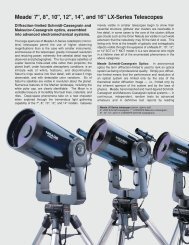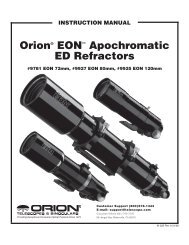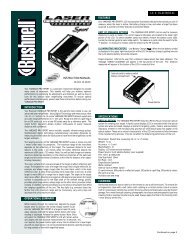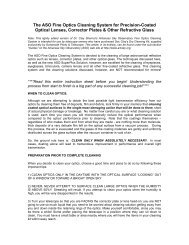Leica Sport Optics
Leica Sport Optics
Leica Sport Optics
You also want an ePaper? Increase the reach of your titles
YUMPU automatically turns print PDFs into web optimized ePapers that Google loves.
A primer for binoculars<br />
Astigmatism Because of the naturally curved shape of a lens, not all light rays<br />
converge on the same plane. While the center of the picture is sharp, the edge of<br />
the picture appears to be out of focus. One can cause objects in one or the other<br />
plane to be rendered sharply by refocusing. In addition, astigmatism causes the<br />
sharpness of an object detail to be influenced by its orientation. This effect becomes<br />
stronger towards the edges of the image. For example, if we look at the corner of<br />
a picture of a chain link fence, it will be noticeable (if astigmatism is present) that<br />
the wires that point towards the center of the image are reproduced with a different<br />
degree of sharpness than those that are oriented at a right angle to them.<br />
By refocusing, one or the other wire direction can be rendered sharply, but not both<br />
of them at the same time. This effect can be reduced by appropriate optical design<br />
measures, but it cannot be eliminated completely. Astigmatism leads to a significant<br />
impairment of the image quality.<br />
Distortion The term distortion is used to describe<br />
the effect that causes the image of an object to<br />
be rendered with a non-uniform reproduction ratio.<br />
For binocular observation, unlike in photography,<br />
this effect is applied quite deliberately to reduce<br />
the so-called “globe effect” caused by perspective<br />
observation and by swinging the binocular. To<br />
the observer, the image created in this manner<br />
appears straightened out. There are two kinds of<br />
distortion : pincushion distortion (illustrated on the<br />
top), and barrel distortion (as shown on the bottom).<br />
Observation through a binocular that does<br />
not have deliberately implemented judicious distortion<br />
is quite unpleasant.<br />
Color errors (chromatic aberrations) Every image-forming<br />
component made of glass – such a lens elements –<br />
refracts light rays of different colors at different angles. This<br />
results in the fact that not all the light rays that emanate<br />
from a multi-colored point on the object are re-united at a<br />
single point in the image. This results in color errors for the<br />
observer. Color errors become particularly evident to the<br />
observer as color fringes when high magnifications and long<br />
focal lengths are being used, as they are in spotting scopes.<br />
Pictorial examples : Color errors appear primarily as color<br />
fringes around dark objects in front of bright backgrounds,<br />
as illustrated by the example on the left with the red-fringed<br />
feather dress. With APO correction of <strong>Leica</strong> (right illustration)<br />
such color effects are no longer discernible.<br />
Optical glasses with anomalous partial dispersion<br />
Light rays of different colors are refracted at different angles<br />
at a lens surface. This effect is called dispersion and in<br />
different types of glass it is present at different levels of<br />
strength. Most types of glass have typical, “normal” characteristics.<br />
Special glasses with “anomalous partial dispersion”,<br />
on the other hand, have characteristics that are different in<br />
certain ranges of colors, and this makes a special color error<br />
correction possible that cannot be achieved with normal types<br />
of optical glass. Glasses with anomalous partial dispersion<br />
are used for the enhancement of image quality, and they are<br />
used in all <strong>Leica</strong> binoculars and spotting scopes.<br />
90 / 91<br />
APO color error correction APO stands for apochromatic<br />
color error correction. It is only beneficial for lenses with long<br />
focal lengths and for high magnifications, like in spotting<br />
scopes. Apochromatic color correction is achieved by the use<br />
of special types of optical glass with anomalous partial dispersion<br />
and with glasses that contain fluorite. Such correction<br />
results in images with enhanced sharpness, increased contrast<br />
and an extremely natural color rendition.<br />
High refraction glasses Lens elements made of high refraction glasses bend light rays more strongly than lenses with the same<br />
shape that are made of standard glasses. Therefore the use of a lens element made of high refraction glass can achieve strong<br />
effect without the need for lenses with excessively strong surface curvatures. This helps to prevent imaging errors, thus leading<br />
to greater imaging performance. High refraction optical glasses are used in all <strong>Leica</strong> binoculars and spotting scopes in order to<br />
make their short construction possible.<br />
ASPH. ASPH. is an abbreviation that denotes the use of at least one aspherical lens surface in an optical system. Unlike regular<br />
spherical lens surfaces, aspherical lenses have a curvature near their edges that is different from the curvature in the center of<br />
the lens. That makes it possible to influence light rays passing through the edges of the lens differently from light rays passing<br />
through the center portion of the lens. It also makes it possible to achieve several correction goals simultaneously with only one<br />
lens element. Furthermore it helps to reduce the weight and the physical size of an optical system and it makes certain imaging<br />
characteristics possible to begin with. Such surfaces help to increase the image quality or to influence the distortion. The fabrication<br />
and the handling of aspherical lens elements is significantly more costly, however, than that of conventional spherical<br />
lenses. In order to assure the extremely high image quality in all models of Ultravid binoculars, aspherical lenses are used effectively<br />
in the 25 mm and 20 mm BR / BL models. 8 x 20 BR / BL and 10 x 25 BR / BL. In the remaining models the high image quality<br />
is achieved by means of complex optical systems that consist of several lens elements.

















